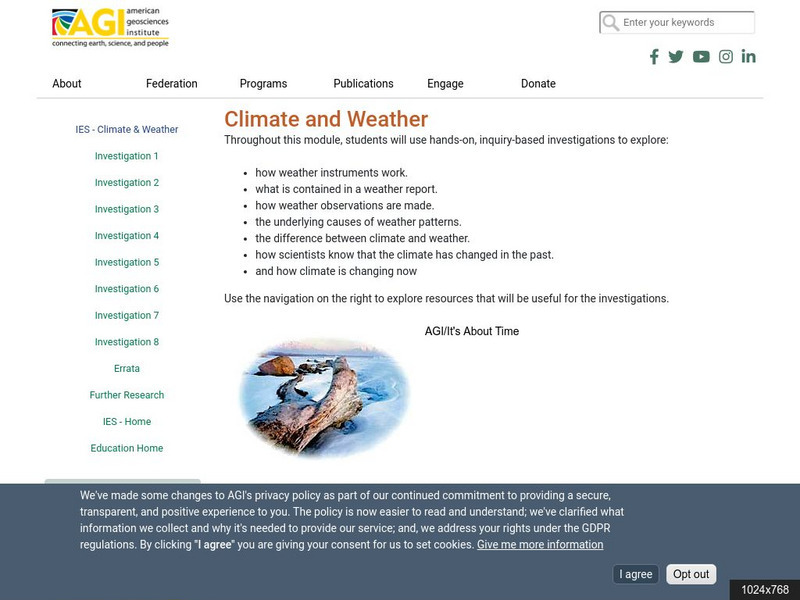Hi, what do you want to do?
Curated OER
Weather Walks
Students study weather by taking walks in various types weather conditions.
Curated OER
Plant Transpiration
Students conduct various experiments to investigate plant transpiration. In this biology lesson, students explain how this process helps maintain the hydrologic cycle. They measure the rate of water loss in plants using a potometer.
K12 Reader
Taiga Ecosystems
After reading a short article about taiga ecosystems, middle schoolers are asked to identify the characteristics of this chilly environment.
US Geological Survey
The Water Cycle for Schools: Beginner Ages
Explore a day in the life of a water droplet. An interactive infographic helps scholars learn how water cycles work from precipitation all the way around to condensation. Learners hover over each step of the cycle to read more as they...
Curated OER
Quiz: Weather Terminology #1
For this science worksheet, 3rd graders focus on the weather. Students respond to ten fill in the blank questions regarding specific terminology used in weather.
Alabama Learning Exchange
Researching Hurricanes with Technology
High schoolers explain the components that make up a hurricane.
Curated OER
Wonders of Weather
Students understand the destructive force of a tornado. They learn the role of a thunderstorm in the creation of a tornado.
Curated OER
Advanced Matching--Weather
Here's a simple matching worksheet to help ELL learners practice weather related vocabulary words. Learners match the weather vocabulary word on the right with the correct definition on the left.
Curated OER
Operation Weather Station
Students work in cooperative groups to create a working weather station. Tkey use the weather station to collect weather data over a one-week period. Students compare the data from their weather station to actual weather information...
Curated OER
Meteorology
Seventh graders examine the job of meteorologists. They decide which characteristics of the atmosphere that meteorologists focus on. They use local weather maps from newspapers to predict weather in their area.
Curated OER
Chasing El Nino
In this El Nino worksheet, students review this specific change in the climate cycle by completing 20 short answer questions.
Curated OER
FROM SEA TO SHINING SEA
Identify agricultural products grown in each region of the country.
Discuss how geography affects what is grown or raised in a particular area.1. Hand out a copy of the two activity sheets "Food From Sea to Shining Sea" to each student....
Curated OER
Weather Station Report
In this science worksheet, students fill out the data report for the seven different questions. The focus is upon the interpretation of data.
Curated OER
Quiz: Weather Terminology #2
In this science worksheet, 3rd graders focus on the weather. Students respond to ten fill in the blank questions regarding weather terminology.
Curated OER
Explorit's Weather Quiz
In this weather worksheet, students complete questions to a quiz about the weather. Students complete 5 questions in the weather quiz.
NOAA
Noaa: National Weather Service: Wind Chill Temperature Index
Provided by the National Weather Service, a chart showing current temperature, wind (mph) and the air temperature with the wind chill. Shows the calculation for wind chill at the bottom of the chart and provides a wind chill calculator.
American Geosciences Institute
American Geosciences Institute: Climate and Weather
Eight hands-on lessons module in which students explore climate and weather. Inquiry-based investigations include observing weather, weather reporting, weather maps, weather satellites, causes of weather, and climate change.
American Geosciences Institute
American Geosciences Institute: Wind Classroom Activities
When air is warmed, it expands and becomes less dense. As the air becomes less dense, its air pressure decreases. This occurs because molecules in warm air have greater kinetic energy (energy of motion) than in cold air. As the molecules...
CPALMS
Florida State University Cpalms: Florida Students: How's the Weather?
A tutorial that describes the five factors that determine the weather in a particular place and time. The factors discussed in this tutorial are air temperature, air pressure, humidity, wind, and precipitation. A PDF file of the tutorial...
Scholastic
Scholastic: Air and Weather
Students chart weather conditions, learn how to determine an average temperature, and build paper gliders to observe the effects of wind.
Georgia Department of Education
Ga Virtual Learning: Weather and Climate
In this amazingly comprehensive interactive tutorial you will learn how factors such as ocean currents, topography, and air currents affect weather patterns. You will also learn the similarities and differences between weather and climate.
McREL International
Mcrel.org: Wind and Temperature [Pdf]
A worksheet regarding the wind direction and average air temperature at different elevations.
National Snow and Ice Data Center
National Snow and Ice Data Center: Factors Affecting Arctic Weather and Climate
An introduction to the factors that affect the Arctic's weather and climate: latitude, land/sea distribution, solar radiation, air temperature, air pressure, winds, humidity, clouds, and precipitation.
American Geosciences Institute
American Geosciences Institute: Earth Science Week: Build Your Own Weather Station
Students are guided in how to build their own weather station that will measure temperature, humidity, precipitation, atmospheric pressure, and wind direction and speed.



























